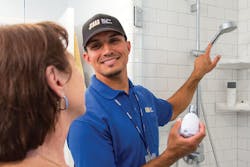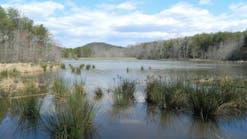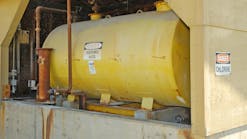Lessons Learned from California's Investor-Owned Water Utilities
By Jack Hawks
When California entered its fourth year of unrelenting drought in 2015, the state regulators took action, forcing all water providers to make fundamental changes in how they operate and to develop plans for sustainable water supplies and financially-sound business operations.
Investor-owned utilities (IOUs) are at the forefront in responding and are leading the way in preparing for tomorrow’s water challenges.
The Call to Action
In April 2015, Governor Jerry Brown issued his third drought-related Executive Order, mandating a series of statewide actions designed to achieve a 25 percent reduction in water use by the urban sector between June 2015 and March 2016, as compared with the same months in 2013.
The State Water Resources Control Board (State Board) was charged with implementing this directive and set reduction targets ranging from 8 to 36 percent for each of the 411 urban water suppliers (more than 3,000 service connections). The California Public Utilities Commission (CPUC), which regulates investor-owned water utilities in the state, quickly followed with two resolutions mandating compliance with the Governor’s Executive Order and conservation targets set by the State Board.
Communities with the highest per capita water use were ordered to conserve the most. Water providers were required to meet their conservation targets or face possible sanctions, ranging from warning letters to financial penalties, potentially up to $10,000 per day.
These actions followed emergency regulations set into place a year earlier to increase water conservation by water providers and their customers, and to prohibit certain wasteful practices such as landscape watering that causes runoff.
The Response
Californians achieved 96 percent of the Governor’s goal, reducing urban water use by 23.9 percent through February 2016, an amount representing savings of nearly 388 billion gallons, demonstrating a huge collaborative commitment and effort.
IOUs led the way in this effort, with 59 of their reporting water districts topping the statewide average by nearly three percentage points. Through February 2016, IOU customers used 26.7 percent less water compared with 2013. Even though the mandatory reduction targets ended (temporarily) on June 1, 2016, the collective percentage of water saved by IOUs remained strong at 24.4 percent - besting the state average of 23.3 percent savings from June through August.
Innovative Outreach and Programs
Each water provider developed its own means of meeting the conservation targets. IOUs implemented a wide range of efforts to educate their customers on the mandated targets and provide them with resources and tools to reduce consumption.
- California American Water created a dedicated web page, offering detailed information about rebates, water surveys and water waste reporting, and drove customers to it using a dedicated mobile app, targeted advertising online and in social media. The utility also embraced direct outreach to customers, sending conservation teams to knock on doors in high-water-using neighborhoods and hosting successful drive- through events to give away toilets, rain barrels and mulch.
- California Water Service added a turf replacement rebate program and toilet delivery program to its existing conservation programs, and it expanded its water-use efficiency evaluations to commercial and industrial customers. The utility sought and received grants from the Department of Water Resources to expand its bathroom fixture replacement program in disadvantaged areas. It also engaged in more than 300 public outreach events, conservation gardening classes, coffee roundtables, and focus groups; ramped up its educational advertising efforts; and rewarded customers who met their water budgets.
- Golden State Water Company developed the Collaborative Conservation Education Campaign to spread the message among its 1 million service population about the importance of using water responsively and to create an open dialogue with customers to share conservation achievements and ideas with their communities. The campaign included contests celebrating conservation accomplishments, community-sharing website forums, and video profiles of customers committed to making conservation a way of life.
- Great Oaks Water Company partnered with WaterSmart Software to provide Home Water Reports to its customers - a conservation program that achieved overwhelming customer engagement and acceptance, as well as conservation in excess of 30 percent.
- Liberty Utilities offered its customers several water-saving programs, including its Ultra High-Efficiency Toilet Program, Conservation Irrigation Nozzle Program, Cash for Grass (turf replacement), and free water-saving devices such as indoor conservation kits, shut-off nozzles, shower timers, and toilet flappers.
- San Gabriel Valley Water Company implemented an active and comprehensive conservation program offering a full range of helpful programs for customers to cut back their water use, including high-efficiency clothes washer rebates, weather-based irrigation controller rebates, rain collection barrel rebates, rotating sprinkler nozzle rebates, online landscape design classes, free water conservation audits, free conservation kits, and helpful conservation tips and fact sheets.
- San Jose Water Company expanded its water audit program, which provides free water audits to single family, multi-family, and commercial customers. The audits identify leaks and inefficient plumbing fixtures and appliances, review irrigation schedules, check for broken sprinkler heads and excessive runoff, and also install complimentary low-flow shower heads and aerators.
- Suburban Water Systems offered many ways for customers to save water, including water-saving rebates on efficient water-using appliances, free toilet replacements, and free landscape workshops. Suburban holds customer-education classes in March and August of each year, providing useful water conservation information and advice.
Other efforts by IOUs include: social media posts highlighting water conservation tips; informational email blasts on the new targets; postcards to high-water users; bill inserts; contests; workshops; and special advertising campaigns.
The State Board has recognized several IOUs as “stand out” conservation leaders. For example, in May 2015, Cal Water’s Bakersfield District achieved a 37 percent reduction, while at the same time San Jose Water Company used 36 percent less water, both compared to the benchmark year of 2013.
The Consequence of Conservation
Conservation had an impact on all water providers’ revenue streams throughout the state as diminished sales meant reduced revenues. Public water agencies tapped into their rate stabilization funds, but many were depleted, forcing those agencies to raise rates.
Most IOUs utilized regulatory mechanisms to help cushion the blow from the mandatory reductions and minimized rate increases. IOUs and the PUC implemented conservation-friendly policies well ahead of the drought emergency to develop tools and procedures so that conservation could be promoted without harming financial stability. Systems put into place included: revenue adjustment mechanisms; conservation memorandum accounts; conservation loss revenues memorandum accounts; and sales reconciliation mechanisms.
Preparing for the Future
Although Northern California enjoyed a modest return to normal precipitation in the winter of 2016, the drought continued into its fifth straight year, especially in Southern California. Because of the changed conditions, including significant investments by many water utilities to improve their local water supplies, the State Board decided in May 2016 to allow municipal water agencies and water IOUs to set their own conservation standards based on a “stress test” of supply reliability. Water providers were required to certify sufficient supplies to withstand three years of continuous drought and orient their existing conservation goals and programs accordingly.
Depending on precipitation levels in the October-December 2016 time frame, the Water Board will determine whether to reimpose the mandated reductions by January 2017.
California is preparing for the future by developing long-term drought management and conservation regulations. Among the permanent fixtures in the long-term regulations will be prohibitions on:
- Using potable water to wash driveways and sidewalks
- Using garden hoses with no automatic shut-off valves to wash cars
- Using potable water for decorative fountains that do not have a recirculating feature
- Using outdoor irrigation on lawns during or within 24 hours of a measurable precipitation event
At this writing, the state is considering water use targets for each of the 411 reporting water suppliers, based on indoor water usage, outdoor water use budgets, and water loss targets, along with water use standards for commercial, institutional, and industrial water users.
IOUs are already taking actions to prepare for the future by increasing the diversity of available sources of supply; investing in local drought resiliency infrastructure such as desalination and groundwater storage facilities; investing in technology that will help reduce water waste and water losses; and providing ongoing customer education focusing on water use efficiency.
The water IOUs are also working with the California Public Utilities Commission to develop necessary regulatory mechanisms, determine necessary investments, and capitalize on the inherent efficiencies and expertise of their employees to ensure they are well-positioned to react and adapt to the state’s long-term conservation regulations, as well as whatever Mother Nature has in store for us all in the foreseeable future.
About the Author: Jack Hawks is the executive director of the California Water Association, a consortium of investor-owned water utilities providing water utility services to customers throughout California.





